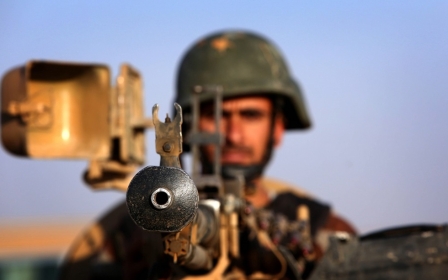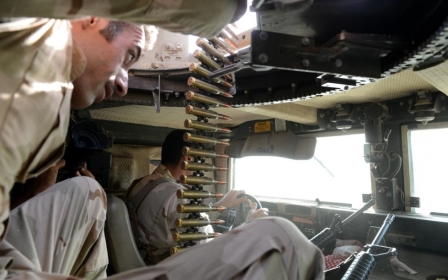Battle against IS masks Iran-US rivalry in Iraq

As much of the international community mobilises to confront the potentially massive threat posed by the emerging Islamic State (IS) in the heart of the Middle East, the two key powers in the region, Iran and the US, look set to continue their intense rivalry in the midst of escalating chaos.
On the face of it, Iran and the United States appear to have arrived at a detente, even minimal cooperation, in Iraq as they fund, arm and directly intervene to bolster their proxies in the fight against a common enemy, the jihadist Islamic State. But behind the scenes Iranian and American interests in Iraq are diverging as the geopolitics of the area, and potentially that of the entire region, shifts in the face of the rapidly elevating status of Islamic militants bent on carving out a caliphate.
Whereas in previous years Iran and the United States competed for influence in a united Iraq, in the wake of the IS advance both powers appear to have implicitly acknowledged the inevitability of Iraq’s breakup. This implicit understanding has come into sharp relief with the division of labour in the pushback against IS, with the US directly intervening to stave off a Kurdish collapse whilst Iran bolsters the embattled government in Baghdad and allied Shiite militias.
While it is relatively clear what long-term geopolitical objectives the two powers are pursuing in respect of the breakup of Iraq – with Iran consolidating influence in the Shiite-dominated south and the US falling behind an independent Kurdish state – what is less clear is the efficacy of the strategies and tactics directed against the emerging Islamic state.
Both Iran and the United States failed to anticipate the dramatic rise of IS and both are scrambling to stall and reverse the advances of this remarkably formidable force. In the midst of the unprecedented chaos engulfing the region there is a real danger that Iranian and American actions, in addition to that of the wider international effort, will backfire, with hugely combustible repercussions across the region.
Business as usual in Baghdad
Whilst Iran, the United States and much of the international community have welcomed the departure of Nouri al-Mailiki and the appointment of Haidar al-Abadi as the new Iraqi Prime Minister, in reality there is little cause for optimism that a supposedly “new” government in Baghdad can do much to contain Iraq’s intensifying centrifugal forces.
Foremost, Al-Abadi signifies cosmetic change and even an entirely new cabinet will not be a significant departure from the norm in Baghdad. The fundamental problems crippling the fading Iraqi state, namely political cronyism, corruption, sectarianism and regional fragmentation, are all but impossible to resolve under the current conditions and circumstances.
The three core regions of Iraq look set on following mutually exclusive agendas and futures. The Kurdish north is now officially seeking independence and will likely receive Western support in pursuit of its strategic objectives. The less coherent Shiite south is scrambling to consolidate control over contested central areas (in particular Diyala province) and most important of all to secure possession of Baghdad. Meanwhile the restive Sunnis are in open revolt against a post-occupation system determined to contain their political ambitions.
Whilst the Kurds and the Shiites can look forward to a post-Iraq future, the embattled Sunnis have less promising options. On a losing streak since the downfall of Saddam Hussein in 2003, Iraqi Sunnis appear to have gambled on an alliance with a virulent sectarian movement intent on demolishing national borders and changing the entire region beyond recognition. Whilst the so-called Islamic State may offer a degree of emancipation to Iraq’s Sunnis, this is likely to come at a huge political and humanitarian cost in view of the martial nature and expansionist aims of this jihadist movement.
The partition of Iraq
The most that Iran and the US can hope for from the Al-Abadi government is that it will create the conditions for a less chaotic breakup of Iraq. Iran, which considers al-Abadi as an ally in the Baghdad establishment, will expect the new Iraqi prime minister to not only protect existing Iranian interests in Iraq but to facilitate the intensification of the Islamic Republic’s influence in Baghdad and the Shiite south.
In the coming months Iran is likely to decrease its intelligence and wider political influence operations in the Kurdish north with a view to concentrating resources and efforts in Baghdad and the south. But in the unlikely event of the Iranian leadership expecting a quid pro quo from the American side, they are likely to be sorely disappointed. The United States will not relinquish Baghdad to exclusive Iranian control without a long and bitter fight.
In the midst of rapidly shifting scenarios and conditions, there is plenty of scope for misunderstanding and miscalculations. Iran and the United States are highly unlikely to spar directly, but they may decide to settle scores by proxy. The oil-rich city of Kirkuk and the broader so-called “disputed” regions may well become a flashpoint, particularly if Iran decides to apply pressure on the Baghdad government to militarily counter Kurdish aspirations for statehood.
The greatest uncertainty centres on the sum effect of the Iranian-US rivalry on the fortunes and positions of IS and the Sunni regions of Iraq and eastern Syria more broadly. Both Iran and the United states have hitherto underestimated IS and not adequately understood the causes and dynamics driving its rapid growth.
There is every reason to believe that the emerging Islamic state will fully exploit the intensifying Iranian-US rivalry to buttress its position in Sunni areas and even to lay the grounds for a future expansion of the caliphate across the region.
- Mahan Abedin is an analyst of Iranian politics. He is the director of the research group Dysart Consulting.
The views expressed in this article belong to the author and do not necessarily reflect the editorial policy of Middle East Eye.
Photo credit: US President Obama in the White House (AFP)
Middle East Eye propose une couverture et une analyse indépendantes et incomparables du Moyen-Orient, de l’Afrique du Nord et d’autres régions du monde. Pour en savoir plus sur la reprise de ce contenu et les frais qui s’appliquent, veuillez remplir ce formulaire [en anglais]. Pour en savoir plus sur MEE, cliquez ici [en anglais].





